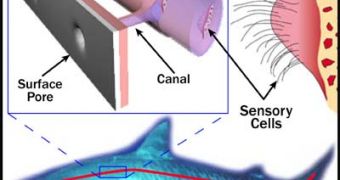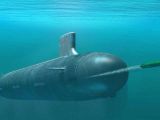A newly developed sensor may be installed on future submarines to allow them to navigate using electric fields just like most marine and freshwater fish do, using the sensor called lateral line.
Fish usually have all the senses that humans use, although in various ratios. Most of them have eyes that have color vision that is at least as good as a human's. Many fish also have specialized cells known as chemoreceptors that are responsible for extraordinary senses of taste and smell. Although they have ears in their heads, many fish may not hear sounds very well. However, most fishes have sensitive receptors that form the lateral line system.
This special sensor allows them to detect slight electric currents and vibrations, as well as to sense the motion of other nearby fish and prey. Sharks detect the electrical discharges in the muscles of the prey and choose as prey the specimens that have spasmodic movements, which usually means they're hurt or dying. The fish from the family of the electric eel, but not only, can even paralyze prey with a powerful discharge of electricity that could even harm humans.
A team of researchers led by Malcolm MacIver at Northwestern University in Chicago, US, have studied the biomechanics of these "weakly electric fish", and have now come up with an artificial electric-field sensing system. They say it could ultimately give robot submersibles the same additional sensory capabilities.
"Currently, no vehicle is maneuverable enough to do work in tight quarters, such as coral reef monitoring, underwater structural inspection, or searching a submerged vessel," said MacIver. "To do so requires not only a high amount of agility, but also being able to sense in all directions, so that you do not collide with nearby obstacles. Electro-location is perfect for this."
The system is made up of two field-emitting electrodes and two voltage-sensing electrodes. These electrode pairs are arranged at opposite corners of a diamond and were submerged in shallow water for testing purposes.
The two electrodes can pick any disturbances in the electric field between them, since any object placed in the field causes variances in the sensor readings.
Consequently, a computer uses the sensor readings to determine the object's location and it can detect small objects by amplifying subtle perturbations in the field.
The first experiments proved highly successful. They attached four sensors to a robot that was then lowered into a shallow tank of water and the sensors were moved around a sphere fixed to the bottom of the tank while readings were taken.
The experiment was repeated with two spheres of different size and in all three cases, the computer pinpointed the exact location of the submerged object to within 3 millimeters after 10 movements.
After the success of these experiments, practical applications will soon be installed on real submarines, the scientists expect.

 14 DAY TRIAL //
14 DAY TRIAL // 
